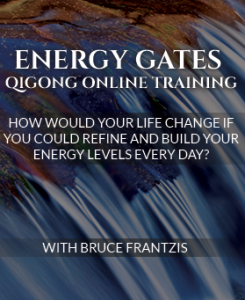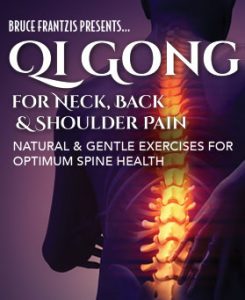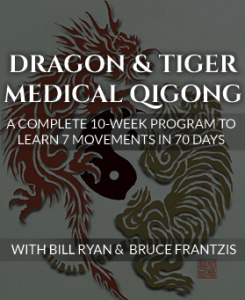There are a multitude of benefits of qigong. Below is a list of some of the reasons why qigong is so effective as an exercise for our modern times. You can click on any of the following links to jump to a benefit lower on this page:
- Qigong Loosens the Muscles and Builds Power
- Qigong Strengthens the Organs
- Qigong Improves Cardio-pulmonary Function
- Qigong Strengthens the Nerves
- Qigong Improves Vascular Function
- Qigong Can Be Used by the Seriously Ill
- Qigong Helps Prevent Injury to Joints, Ligaments and Bones
- Qigong Speeds Recovery Time from Injuries and Operations
- Qigong Builds Athletic and Martial Arts Power
- Qigong Eases Stress and Balances Emotions
- Benefits Sedentary Workers and Meditators
Qigong Loosens the Muscles and Builds Power
Qigong works with the muscles quite differently than the typical exercises practiced by Westerners. Aerobics and vigorous stretching build strength and flexibility; qigong and other internal exercises build effortless power and looseness. The feeling of strength, of being “pumped up,” obtained in Western exercise is actually due to muscular contraction, that prevents the free flow of chi, even though such exercise may give you the extreme flexibility to be able to do leg splits, for example.
In the internal arts, the feeling of muscular strength is considered inappropriate; the goal, rather, is a feeling of relaxed power. Relaxed power comes when the muscles, rather than fighting and straining to do something, just loosen (open up) and allow the energy to flow through.
Qigong Strengthens the Organs
The qigong techniques in the Energy Arts Qigong Exercise Program work to strengthen and balance all the internal organs. There are also other techniques to strengthen specific organs: to help the liver recover from hepatitis, for instance, or the lungs from tuberculosis, or the heart from a heart attack. Even without having had a serious illness, almost everyone is born with a weakness in one organ or another, and chi gung has precise exercises to address an individual’s specific problems.
Qigong Improves Cardio-pulmonary Function
Most people think that aerobic exercise is necessary to strengthen the heart and lungs. While aerobic exercise does accomplish this, so does qigong. Slow, deep, regular breathing and energy movement combine to work oxygen deeper into the tissues than regular exercise.
One case in point: a qigong student who holds a normal, sedentary office job and engages in almost no aerobic activity has a brother who is a well-known mountaineer. Invited to climb a mountain in Colorado with his brother, he imagined himself gasping for air as his brother marched ahead, but much to his surprise he found that his capacity for physical activity, in terms of breath, had actually come to surpass that of his brother, who engaged in aerobic activity continuously.
Qigong Strengthens the Nerves
A primary way chi flows is along the nerves of the body. Although at advanced levels of development chi and the nerves can be felt separately, the great majority of beginners only have an awareness of their nerves.
The nerves are an intermediary between the body and the mind, and it is through the nerves that we can gain access to information about our body. Much of the initial qigong work, which emphasizes getting in touch with the body and clearing out blockages, is accomplished through the nervous system. As your chi gets stronger through continued practice, your nerves are strengthened and your body awareness is enhanced. People with poor coordination and other motor problems can benefit greatly. The spinal nerves play a vital role in overall health. Indeed, the entire chiropractic system is based on the importance of spinal nerve flow.
Like the nerves, chi is also an intermediary between the body and the mind, and while it travels with nerve impulses, it can, with practice, be felt independently. It is commonly said in the internal arts that the mind moves the chi, and the chi moves the body. While this is true, it is important to be aware that most beginners need to work through the nerves first.
Qigong’s ability to strengthen the nervous system makes it a magnificently effective technique for relieving stress on a day-to-day basis, as well as rebuilding bodies that have broken down due to long-term stress.
Qigong Improves Vascular Function
Western aerobics increase circulation by exercising the heart. Qigong improves circulation by increasing the elasticity of the blood vessels themselves. It is standard in China to prescribe qigong exercises for both high and low blood pressure, as both are due to problems in vascular elasticity and strength.
Qigong Can Be Used by the Seriously Ill
Western exercise utilizes either motion or resistance to motion to strengthen the body (for example, weight training, calisthenics, running). Unfortunately, the seriously ill and bedridden often do not have the capacity for vigorous exercise. This means that the muscles and organ systems get weaker during prolonged bed rest, and it may take months to get back to normal after recovery from the main problem (a back injury, for instance).
Qigong, however, has many techniques specifically designed for the weak and immobile, techniques which increase physical capacities without requiring movement. In China, qigong is also prescribed for terminally ill cancer patients as a last resort. If they don’t initially have the strength to practice while standing or sitting, they can practice lying down until their strength builds up.
Qigong Helps Prevent Injury to Joints, Ligaments and Bones
Accidental injury can occur in many ways and joints and ligaments are particularly vulnerable. People habitually lock their joints when falls or accidents occur, and a locked joint is an easily broken joint. Ligaments can easily be overstretched in an accident and getting them to bounce back is very difficult.
Qigong teaches better balance; it also teaches how to turn correctly without straining, to move your joints without locking them and how to relax during a fall. Qigong increases flexibility and the spring of ligaments. Qigong is like a good gentle stretch and an acupuncture treatment combined, which improves the circulation of fluids and energy in the body to lessen the impact of injuries and allow more rapid healing.
Practitioners of qigong learn to avoid strain and stay well within their 70 percent capacity, and, in particular, not to overstrain if there is already some pain or restriction.
Qigong balances energy and improves the weaker areas in people’s internal systems. The aim is to prevent the body’s “weak links” from causing problems down the road.
Qigong Speeds Recovery Time from Injuries and Operations
The gentle, non-jarring and low-impact movements of qigong can be done immediately following an injury or operation, particularly if the 70 percent rule is adhered to and no strain is applied. This rule is particularly important during healing, as the body is already overstressed.
First, parts of the body that were not injured can be gently moved and exercised. These movements will increase the circulation of bodily fluids and the flow of energy to all parts of the body. The lymph system will be energized, which helps to improve the immune system. Opening the energy channels will enable the natural healing abilities of the body to accelerate rapidly.
Second, qigong helps the entire body and mind to relax. During injuries, the body and mind tense. Tension in the uninjured areas of the body will suck up chi necessary to heal the injured parts. Qigong helps to relax the parts of the body that were not injured. This gradually takes tension out of the body to help the body heal faster. Doing something proactive and effective to speed recovery also can diminish anger and fear.
Applying the rule of no strain helps injuries to heal fully. The 70 percent rule allows recovery to happen gradually and fully. Injuries that are only partially resolved can progressively weaken other parts of the body and set up conditions for major problems in uninjured areas, immediately or over time.
Qigong Builds Athletic and Martial Arts Power
Qigong is the basis of the power of the Chinese martial arts, whether kung fu, or the more subtle internal forms, such as tai chi, hsing-i, and ba gua. It is almost impossible to determine from an external view how the seemingly gentle, smooth movements of the internal forms enable the advanced practitioner to defeat the most violent street fighter. This capability is basically derived from the practice of qigong, which develops chi and internal power.
People who train in the internal martial arts will find that practicing the material revealed in this book will enable them to surpass inherent physical strength and athletic abilities.
Qigong Eases Stress and Balances Emotions
Much of the new literature on stress indicates that one of the largest factors in determining stress levels is the emotions. Most physical exercise is at least somewhat useful for relieving anger, but one need only look at the behavior of some top athletes to see that typical physical activity does not necessarily balance the emotions.
The clearing process in chi gung can be used on strongly repressed, as well as on spontaneously over-expressed emotions. Many of the movements of chi gung can be refined to specifically address your problem area, be it depression, grief, frustration, irritability, or any combination thereof.
Stress-related problems in our society are worsening, so it is urgent to gain the ability to convert the energy of negative and destructive emotions to those that are more positive in nature. The ability to release stress directly through control of the central nervous system is a method par excellence for dealing with burnout.
Benefits Sedentary Workers and Meditators
Sitting too long can weaken your body. The circulation of your fluids becomes sluggish and your tension increases. This strains your nervous system, which lessens the ability of your mind to remain fully awake and concentrate on meditation or prayers.
A classic story handed down from the sixth century is that a Buddhist master came to China’s Shaolin Temple, which became the home of Chan Buddhism. He found that the monks would easily become distracted and would even fall asleep during meditation. He realized that their sincerity was genuine but their energy was not always up to the task. The Buddhist master taught the monks a form of qigong that later became the basis of China’s Shaolin chi gung school. Chan Buddhism was later taken to Japan and became the foundation for Zen Buddhism.
The purpose of teaching monks chi gung was to provide them with a stable internal body and energy structure to keep them physically comfortable and mentally alert. Qigong enabled them to sit cross-legged on the floor comfortably for prolonged periods, without stiffness, pain or loss of energy.
The qigong exercises in this book can do the same for anyone engaged in long periods of prayer or meditation, whether sitting on the floor or in a chair. In the same way, these exercises will help anyone in a sedentary job to be better able to concentrate and stay comfortable when sitting at a desk or computer for hours at a time.






0 Comments